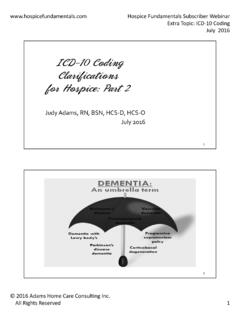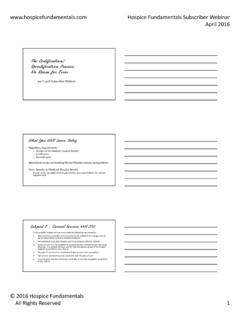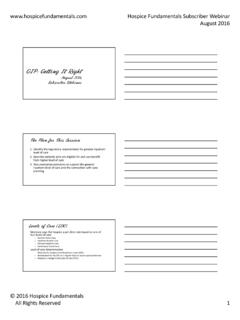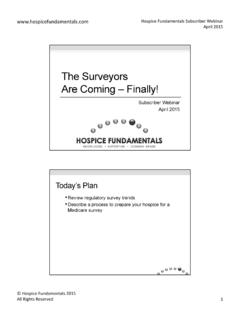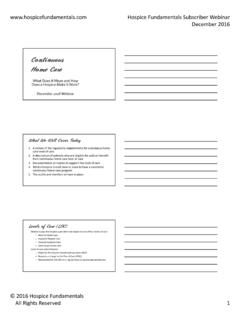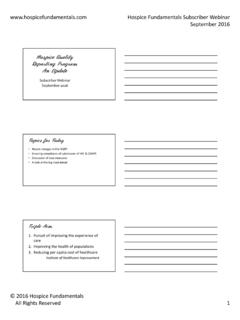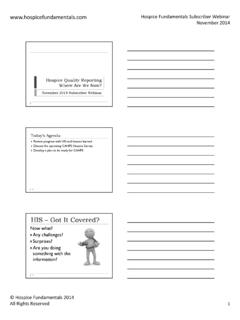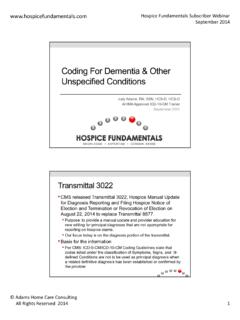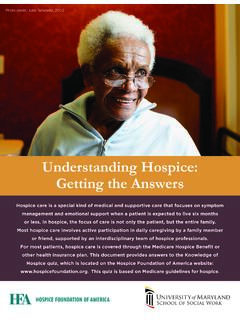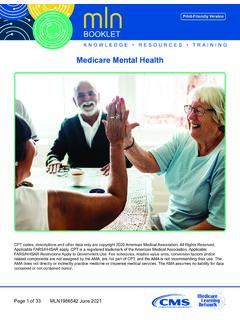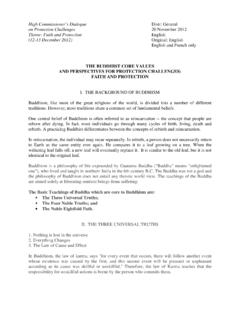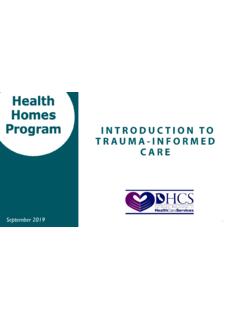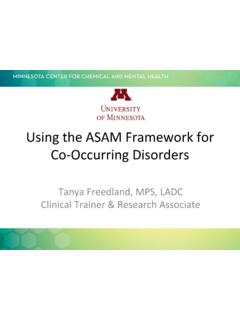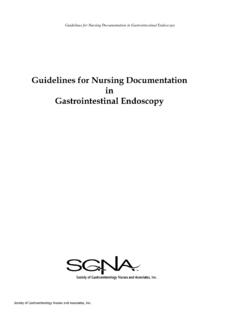Transcription of Coding Update Part 1 - Hospice Fundamentals
1 Fundamentals Subscriber WebinarExtra Topic: ICD 10 Coding July 2016 2016 Adams Home Care Consulting Inc. All Rights Reserved1 ICD-10 Coding Clarifications for Hospice : Part 1 Judy Adams, RN, BSN, HCS D, HCS OJuly 2016 ICD-10-CM Has Been Here for 9 Months The implementation of ICD 10 CM has generally gone smoother than many expected. However, as with anything new, there have been many changes in interpretation and guidance. The more we get into ICD 10, the more questions have arisen about how best to code or sequence Hospice situations. To add to the uncertainty, there continues to be new expectations from CMS regarding Coding for Hospice . Today s session is aimed at trying to tackle some of the questions that are common to many Hospice programs. Fundamentals Subscriber WebinarExtra Topic: ICD 10 Coding July 2016 2016 Adams Home Care Consulting Inc. All Rights Reserved2 Coding for Hospice Patients CMS continues to clarify diagnosis reporting on Hospice claims, moving from a primary Hospice diagnosis to including all related and non related conditions that impact the terminal condition or prognosis of each Hospice patient.
2 Hospice programs, as all health care settings, are required to follow the ICD 10 CM Official Guidelines for Coding and Reporting Diagnoses, published by the Coordination and Maintenance Committee, often referred to as the Cooperating Parties. A copy of the Official Guidelines is located in the front of every Coding manual. An updated version for 2017 is expected to be released anytime between now and October 1, 2016. ICD-10-CM 2016 Official GuidelinesFor Coding and Reporting Diagnoses: Selection of the Principal Diagnosis The principal diagnosis is defined in the Uniform Hospital Discharge Data Set (UHDDS) as that condition established after study to be chiefly responsible for occasioning the admission of the patient to the hospital for care. In the case of selection of the principal diagnosis for Hospice care, this would mean the diagnosis most contributory to the terminal prognosis of the individual.
3 In the instance where two or more diagnoses equally meet the criteria for principal diagnosis, ICD 10 CM Coding guidelines do not provide sequencing direction, and thus, any one of the diagnoses may be sequenced first, meaning to report all of those diagnoses meeting the criteria as a principal diagnosis. (Section II) Fundamentals Subscriber WebinarExtra Topic: ICD 10 Coding July 2016 2016 Adams Home Care Consulting Inc. All Rights Reserved3 Assigning DiagnosesAll health settings, including Hospice , must code allconditions/ diagnoses that are related to the reason you are seeing the patient. If the Hospice patient has diagnoses non related to their terminal condition, the Hospice physician should document why those diagnoses or conditions are not related to the patient s terminal status and that information should be in the medical record. Hospice personnel should add additional documentation to the medical record to fully explain each patient s situation such as documentation of recent history and the physical and mental codes can be changed at any time the patient s condition changes, but should be documented in the medical record along with the rationale for making the to Apply in Designating Other Diagnoses The listing of the diagnoses in the patient record is the responsibility of the Hospice medical director and the attending providers include in the diagnostic statement resolved conditions or diagnoses and status post procedures from previous admissions that have no bearing on the current stay.
4 Such conditions are not to be reported. History codes may be used as secondary codes if the historical condition has an impact on the current care or influences codes should not be coded is they have no impact on the patient s current Fundamentals Subscriber WebinarExtra Topic: ICD 10 Coding July 2016 2016 Adams Home Care Consulting Inc. All Rights Reserved4 Guidelines (continued)Abnormal findings (lab reports, x rays, pathologic and other results are not coded and required unless the provider indicates their clinical significance and plans to continue monitoring diagnostic studies (a rare situation in Hospice ). Uncertain diagnoses, qualified as probable, suspected, likely, questionable or other similar terms can only be coded by short term, acute, long term care and psychiatric about Determining Terminal Prognosis?The basic foundation of the Hospice benefit is that it is designed to provide palliative and symptom management to a patient who has a life expectancy of six months or less.)
5 (prognosis).Most patients have multiple diagnoses or needs that are based on their unique physical and mental health history and current status. Some of these needs no long impact orhave an increased impact on the patient as he or she progresses to the terminal stage of life. Treatments directed at some long term conditions may present more harm than benefit or are determined to be ineffectual or not palliative therapy within the terminal phase of life. Some chronic diagnoses are long standing and stable and have no impact on (no contribution to) the terminal prognosis. Fundamentals Subscriber WebinarExtra Topic: ICD 10 Coding July 2016 2016 Adams Home Care Consulting Inc. All Rights Reserved5 View Each Patient as A Unique Individual A shift to viewing each patient as a unique and individual situation as they approach the terminal phase of life enables the Hospice of today to see the patient in a holistic manner and recognize that many conditions and factors affect the care of the patient during this last stage of life.
6 Even patients with the same or a similar array of long term chronic conditions may have a different impact from their diagnoses on their terminal prognosis. A clear and complete documentation of the patient s current and ongoingphysical, mental, spiritual and social functional level goes further to establish their appropriateness for Hospice care than any specific Through Potential DiagnosesDelete diagnoses that are not true diagnoses or that no longer apply now that the patient is at the terminal stage of life. Many times medical records list a diagnosis of an event in the past, but there is no current treatment and has been no recurrence this is a history diagnosis and Coding guidelines instruct not to code these unless it somehow impacts the patient s current condition. Examples hyperlipidemia, hypercholesterolemia potentially a patient who developed adult onset type 2 diabetes primarily due to life style factors and now that the patient is no longer overeating, using excessive alcohol, overweight, etc.
7 , they no longer require any treatment for the diabetes nor exhibit any symptoms. Fundamentals Subscriber WebinarExtra Topic: ICD 10 Coding July 2016 2016 Adams Home Care Consulting Inc. All Rights Reserved6 Basic Coding RemindersAlldiagnosis or condition codes must be stated or confirmed by a physician or other qualified health care practitioner who is legally accountable for establishing the patient s diagnosis. (Introduction to ICD 10CM Official Guidelines for Coding and Reporting)The term in conditions classified elsewhere is a convention that requires the coder to follow the same sequencing rules as etiology/manifestation convention:Code the etiology (cause) first!The term, use an additional code .. is also a convention and means to add an additional is Responsible for Ensuring Eligibility?The Hospice agency is ultimately responsible for ensuring that all patients served by the Hospice meet the eligibility criteria for the Medicare (and other payer) eligibility criteria and that the services provided are medically reasonable and necessary.
8 Hospice is based on the fundamental principles of providing holistic care utilizing an interdisciplinary team, which includes the medical director, to manage and monitor the care to each patient throughout their length of IDG team should also use their collective knowledge and experience to determine what diagnoses actually are currently active for each patient. Fundamentals Subscriber WebinarExtra Topic: ICD 10 Coding July 2016 2016 Adams Home Care Consulting Inc. All Rights Reserved7 Diagnoses Are Not Static As a patient moves through the terminal phase of life, diagnoses may change some no longer appropriate and new diagnoses appear No changes in the diagnoses or order of diagnoses over a prolonged period can send a message of stability and lack of change occurring in the patient s condition. The Hospice Medical Director is primarily responsible to identify the terminal prognosis for each Hospice patient, by identifying the contributing diagnoses, the appropriate treatment and determine and document what diagnoses are unrelated to the terminal of the members of the IDT/IDG has unique perspectives to contribute to the patient and caregiver and the evaluation and development of the overall plan of care.
9 Guide to Sequencing DiagnosesSequencing diagnoses is influenced by: Instructional notes within the code set (code first, add an additional code, etc. ) Ordering the diagnoses based on the level of contribution toward the terminal prognosis. General order sequence: Principal diagnosis or multiple diagnoses that meet the requirement as principal diagnosis. Other active diagnoses that are related to and impact the current care Z codes can be useful to describe a patient s condition, but are less specific than medical diagnoses Non related diagnoses Fundamentals Subscriber WebinarExtra Topic: ICD 10 Coding July 2016 2016 Adams Home Care Consulting Inc. All Rights Reserved8 How Many Diagnoses Should Be Coded?There is no magical number of diagnoses that should be coded Claims can accommodate up to 25 diagnoses Many software systems limit the number of diagnoses that can be listed to 10. If there are additional diagnoses that that cannot be placed in the diagnoses section, they can be added as a narrative to the plan of care in the orders section.
10 CMS requires Hospice to code all diagnoses, related and non related that a patient has that are current or active diagnoses. Many information systems automatically pull the diagnoses listed on the Plan of Care to the claim form. Use critical thinking when determining current diagnoses and avoid listing unnecessary history codes or codes for conditions that no longer Problematic Areas Fundamentals Subscriber WebinarExtra Topic: ICD 10 Coding July 2016 2016 Adams Home Care Consulting Inc. All Rights Reserved9 Some Coding Topics Lead to Many QuestionsSome of the top problematic areas in Hospice Coding Use of Symptom Codes Dementia Use of combination codes, particularly Hypertension and chronic kidney disease and hypertensive heart failure and heart diseases Sequencing primary and secondary cancers How to code diagnoses that do not have a listing in the Coding manuals such as end stage liver or heart failure.
